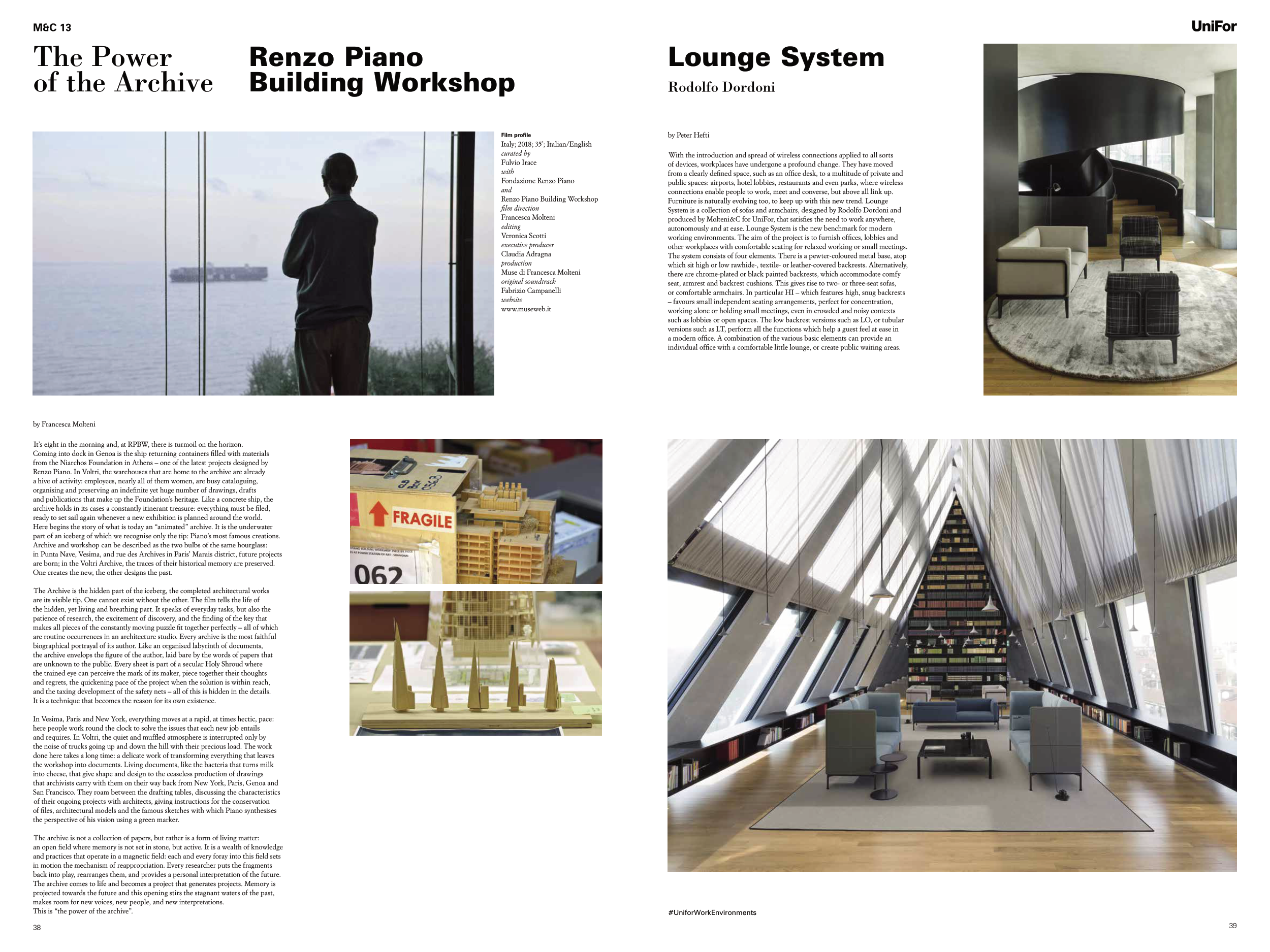38
39
The Power
of the Archive
Renzo Piano
Building Workshop
by Peter Hefti
by Francesca Molteni
M&C 13
Lounge System
Rodolfo Dordoni
#UniforWorkEnvironments
Film profile
Italy; 2018; 35’; Italian/English
curated by
Fulvio Irace
with
Fondazione Renzo Piano
and
Renzo Piano Building Workshop
film direction
Francesca Molteni
editing
Veronica Scotti
executive producer
Claudia Adragna
production
Muse di Francesca Molteni
original soundtrack
Fabrizio Campanelli
website
www.museweb.it
It’s eight in the morning and, at RPBW, there is turmoil on the horizon.
Coming into dock in Genoa is the ship returning containers filled with materials
from the Niarchos Foundation in Athens – one of the latest projects designed by
Renzo Piano. In Voltri, the warehouses that are home to the archive are already
a hive of activity: employees, nearly all of them women, are busy cataloguing,
organising and preserving an indefinite yet huge number of drawings, drafts
and publications that make up the Foundation’s heritage. Like a concrete ship, the
archive holds in its cases a constantly itinerant treasure: everything must be filed,
ready to set sail again whenever a new exhibition is planned around the world.
Here begins the story of what is today an “animated” archive. It is the underwater
part of an iceberg of which we recognise only the tip: Piano’s most famous creations.
Archive and workshop can be described as the two bulbs of the same hourglass:
in Punta Nave, Vesima, and rue des Archives in Paris’ Marais district, future projects
are born; in the Voltri Archive, the traces of their historical memory are preserved.
One creates the new, the other designs the past.
The Archive is the hidden part of the iceberg, the completed architectural works
are its visible tip. One cannot exist without the other. The film tells the life of
the hidden, yet living and breathing part. It speaks of everyday tasks, but also the
patience of research, the excitement of discovery, and the finding of the key that
makes all pieces of the constantly moving puzzle fit together perfectly – all of which
are routine occurrences in an architecture studio. Every archive is the most faithful
biographical portrayal of its author. Like an organised labyrinth of documents,
the archive envelops the figure of the author, laid bare by the words of papers that
are unknown to the public. Every sheet is part of a secular Holy Shroud where
the trained eye can perceive the mark of its maker, piece together their thoughts
and regrets, the quickening pace of the project when the solution is within reach,
and the taxing development of the safety nets – all of this is hidden in the details.
It is a technique that becomes the reason for its own existence.
In Vesima, Paris and New York, everything moves at a rapid, at times hectic, pace:
here people work round the clock to solve the issues that each new job entails
and requires. In Voltri, the quiet and muffled atmosphere is interrupted only by
the noise of trucks going up and down the hill with their precious load. The work
done here takes a long time: a delicate work of transforming everything that leaves
the workshop into documents. Living documents, like the bacteria that turns milk
into cheese, that give shape and design to the ceaseless production of drawings
that archivists carry with them on their way back from New York, Paris, Genoa and
San Francisco. They roam between the drafting tables, discussing the characteristics
of their ongoing projects with architects, giving instructions for the conservation
of files, architectural models and the famous sketches with which Piano synthesises
the perspective of his vision using a green marker.
The archive is not a collection of papers, but rather is a form of living matter:
an open field where memory is not set in stone, but active. It is a wealth of knowledge
and practices that operate in a magnetic field: each and every foray into this field sets
in motion the mechanism of reappropriation. Every researcher puts the fragments
back into play, rearranges them, and provides a personal interpretation of the future.
The archive comes to life and becomes a project that generates projects. Memory is
projected towards the future and this opening stirs the stagnant waters of the past,
makes room for new voices, new people, and new interpretations.
This is “the power of the archive”.
With the introduction and spread of wireless connections applied to all sorts
of devices, workplaces have undergone a profound change. They have moved
from a clearly defined space, such as an office desk, to a multitude of private and
public spaces: airports, hotel lobbies, restaurants and even parks, where wireless
connections enable people to work, meet and converse, but above all link up.
Furniture is naturally evolving too, to keep up with this new trend. Lounge
System is a collection of sofas and armchairs, designed by Rodolfo Dordoni and
produced by Molteni&C for UniFor, that satisfies the need to work anywhere,
autonomously and at ease. Lounge System is the new benchmark for modern
working environments. The aim of the project is to furnish offices, lobbies and
other workplaces with comfortable seating for relaxed working or small meetings.
The system consists of four elements. There is a pewter-coloured metal base, atop
which sit high or low rawhide-, textile- or leather-covered backrests. Alternatively,
there are chrome-plated or black painted backrests, which accommodate comfy
seat, armrest and backrest cushions. This gives rise to two- or three-seat sofas,
or comfortable armchairs. In particular HI – which features high, snug backrests
– favours small independent seating arrangements, perfect for concentration,
working alone or holding small meetings, even in crowded and noisy contexts
such as lobbies or open spaces. The low backrest versions such as LO, or tubular
versions such as LT, perform all the functions which help a guest feel at ease in
a modern office. A combination of the various basic elements can provide an
individual office with a comfortable little lounge, or create public waiting areas.


